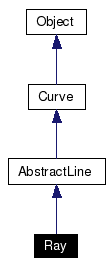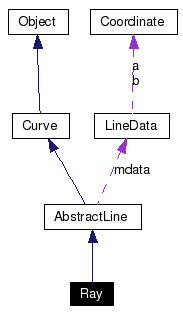Ray Class Reference
An Object representing a ray. More...Inheritance diagram for Ray:


Public Member Functions | |
| Ray (const Coordinate &a, const Coordinate &b) | |
| Construct a ray, starting at a, and going through b. | |
| Ray (const LineData &d) | |
| Construct a ray from a LineData. | |
| Object * | transform (const Transformation &) const |
| Return this Object, transformed by the transformation t. | |
| Ray * | copy () const |
| Returns a copy of this Object. | |
| const ObjectType * | type () const |
| Returns the lowermost ObjectType that this object is an instantiation of. | |
| bool | containsPoint (const Coordinate &p, const KigDocument &doc) const |
| Return whether this Curve contains the given point. | |
Static Public Member Functions | |
| static const ObjectType * | stype () |
| Returns the ObjectType representing the Ray type. | |
Detailed Description
An Object representing a ray.This means half of a line, it is infinite in one direction, but ends at a certain point in the other direction..
Member Function Documentation
|
||||||||||||
|
Return whether this Curve contains the given point. This is implemented as a numerical approximation. lementations can/should use the value test_threshold in common.h as a threshold value. Implements Curve. |
|
|
Returns a copy of this Object. The copy is an exact copy. Changes to the copy don't affect the original. Implements Curve. |
|
|
Returns the ObjectType representing the Ray type.
Reimplemented from AbstractLine. |
|
|
Returns the lowermost ObjectType that this object is an instantiation of. E.g. if you want to get a string containing the internal name of the type of an object, you can do:
tn = object.type().internalName() Implements Object. |

